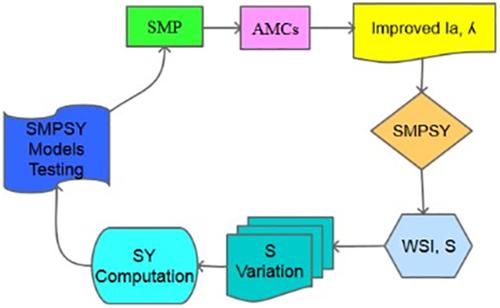当前位置:
X-MOL 学术
›
Hydrol. Process.
›
论文详情
Our official English website, www.x-mol.net, welcomes your
feedback! (Note: you will need to create a separate account there.)
Rainstorm‐generated sediment yield model based on soil moisture proxies (SMP)
Hydrological Processes ( IF 2.8 ) Pub Date : 2020-06-21 , DOI: 10.1002/hyp.13789 Sushindra Kumar Gupta 1 , Pushpendra K. Singh 2 , Jaivir Tyagi 3 , Gunwant Sharma 1 , Ajay Singh Jethoo 1
Hydrological Processes ( IF 2.8 ) Pub Date : 2020-06-21 , DOI: 10.1002/hyp.13789 Sushindra Kumar Gupta 1 , Pushpendra K. Singh 2 , Jaivir Tyagi 3 , Gunwant Sharma 1 , Ajay Singh Jethoo 1
Affiliation

|
This study develops improved Soil Moisture Proxies (SMP) based suspended sediment yield (SMPSY) models corresponding to three antecedent moisture conditions (AMCs) (i.e., AMC‐I‐AMC‐III) by coupling the improved initial abstraction (Ia‐λ) model, the SMA procedure and the SMP concept for modelling the rainfall generated suspended sediment yield. The SMPSY models specifically incorporate a watershed storage index (S) model to accentuate the transformation from storm to storm and to avoid the sudden jumps in sediment yield computation. The workability of the SMPSY models is tested using a large dataset of rainfall and sediment yield (98 storm events) from twelve small watersheds and a comparison has been made with the existing MSY model. The goodness‐of‐fit (GOF) statistics is evaluated in terms of the Nash Sutcliffe efficiency (NSE), and error indices, i.e., root mean square error (RMSE), normalized root mean square error (nRMSE), standard error (SE), mean absolute error (MAE), and RMSE‐observations standard deviation ratio (RSR). The NSE values vary from 74.31% to 96.57% and from 75.21% to 91.78%, respectively for the SPMSY and MSY model. The NSE statistics indicate that the SMPSY model has lower uncertainty in simulating sediment yield as compared to the MSY model. The error indices are lower for the SMPSY model than the MSY model for most of the watersheds. These results show that the SMPSY model has less uncertainty and performs better than the MSY model. A sensitivity analysis of the SMPSY model shows that the parameter β is most sensitive followed by parameter S, α and A. Overall, the results show that the characterization of soil moisture variability in terms of SMPs and incorporation of improved delivery ratio and runoff coefficient relationship improves the simulation of the erosion and sediment yield generation process.
中文翻译:

基于土壤湿度代理(SMP)的暴雨产生的沉积物产量模型
这项研究通过耦合改进的初始抽象(I a)来开发基于土壤水分代理(SMP)的,对应于三个先前湿度条件(AMC)(即AMC-I-AMC-III)的悬浮泥沙产量(SMPSY)模型。‐λ)模型,SMA程序和SMP概念,用于对降雨产生的悬浮沉积物产量进行建模。SMPSY模型专门结合了分水岭存储指数(S)模型,以强调风暴之间的转换,并避免了沉积物产量计算中的突然跳跃。使用来自12个小流域的大量降雨和沉积物产量(98个风暴事件)测试了SMPSY模型的可操作性,并与现有MSY模型进行了比较。拟合优度(GOF)统计数据是根据Nash Sutcliffe效率(NSE)和误差指数(即均方根误差(RMSE),归一化均方误差(nRMSE),标准误差(SE))进行评估的),平均绝对误差(MAE)和RMSE观测标准偏差比(RSR)。NSE值从74.31%到96不等。对于SPMSY和MSY模型,分别为57%和从75.21%到91.78%。NSE统计数据表明,与MSY模型相比,SMPSY模型在模拟沉积物产量方面具有较低的不确定性。对于大多数流域,SMPSY模型的误差指数低于MSY模型。这些结果表明,SMPSY模型的不确定性较小,并且性能优于MSY模型。对SMPSY模型的敏感性分析表明,参数β最敏感,其次是参数S,α和A。总体而言,结果表明,根据SMPs表征了土壤水分变异性,并结合了改善的输送比和径流系数关系改进了侵蚀和泥沙产生过程的模拟。NSE统计数据表明,与MSY模型相比,SMPSY模型在模拟沉积物产量方面具有较低的不确定性。对于大多数流域,SMPSY模型的误差指数低于MSY模型。这些结果表明,SMPSY模型的不确定性较小,并且性能优于MSY模型。对SMPSY模型的敏感性分析表明,参数β最敏感,其次是参数S,α和A。总体而言,结果表明,根据SMPs表征了土壤水分变异性,并结合了改善的输送比和径流系数关系改进了侵蚀和泥沙产生过程的模拟。NSE统计数据表明,与MSY模型相比,SMPSY模型在模拟沉积物产量方面具有较低的不确定性。对于大多数流域,SMPSY模型的误差指数低于MSY模型。这些结果表明,SMPSY模型的不确定性较小,并且性能优于MSY模型。对SMPSY模型的敏感性分析表明,参数β最敏感,其次是参数S,α和A。总体而言,结果表明,根据SMPs表征了土壤水分变异性,并结合了改善的输送比和径流系数关系改进了侵蚀和泥沙产生过程的模拟。对于大多数流域,SMPSY模型的误差指数低于MSY模型。这些结果表明,SMPSY模型的不确定性较小,并且性能优于MSY模型。对SMPSY模型的敏感性分析表明,参数β最敏感,其次是参数S,α和A。总体而言,结果表明,根据SMPs表征了土壤水分变异性,并结合了改善的输送比和径流系数关系改进了侵蚀和泥沙产生过程的模拟。对于大多数流域,SMPSY模型的误差指数低于MSY模型。这些结果表明,SMPSY模型的不确定性较小,并且性能优于MSY模型。对SMPSY模型的敏感性分析表明,参数β最敏感,其次是参数S,α和A。总体而言,结果表明,根据SMPs表征了土壤水分变异性,并结合了改善的输送比和径流系数关系改进了侵蚀和泥沙产生过程的模拟。
更新日期:2020-06-21
中文翻译:

基于土壤湿度代理(SMP)的暴雨产生的沉积物产量模型
这项研究通过耦合改进的初始抽象(I a)来开发基于土壤水分代理(SMP)的,对应于三个先前湿度条件(AMC)(即AMC-I-AMC-III)的悬浮泥沙产量(SMPSY)模型。‐λ)模型,SMA程序和SMP概念,用于对降雨产生的悬浮沉积物产量进行建模。SMPSY模型专门结合了分水岭存储指数(S)模型,以强调风暴之间的转换,并避免了沉积物产量计算中的突然跳跃。使用来自12个小流域的大量降雨和沉积物产量(98个风暴事件)测试了SMPSY模型的可操作性,并与现有MSY模型进行了比较。拟合优度(GOF)统计数据是根据Nash Sutcliffe效率(NSE)和误差指数(即均方根误差(RMSE),归一化均方误差(nRMSE),标准误差(SE))进行评估的),平均绝对误差(MAE)和RMSE观测标准偏差比(RSR)。NSE值从74.31%到96不等。对于SPMSY和MSY模型,分别为57%和从75.21%到91.78%。NSE统计数据表明,与MSY模型相比,SMPSY模型在模拟沉积物产量方面具有较低的不确定性。对于大多数流域,SMPSY模型的误差指数低于MSY模型。这些结果表明,SMPSY模型的不确定性较小,并且性能优于MSY模型。对SMPSY模型的敏感性分析表明,参数β最敏感,其次是参数S,α和A。总体而言,结果表明,根据SMPs表征了土壤水分变异性,并结合了改善的输送比和径流系数关系改进了侵蚀和泥沙产生过程的模拟。NSE统计数据表明,与MSY模型相比,SMPSY模型在模拟沉积物产量方面具有较低的不确定性。对于大多数流域,SMPSY模型的误差指数低于MSY模型。这些结果表明,SMPSY模型的不确定性较小,并且性能优于MSY模型。对SMPSY模型的敏感性分析表明,参数β最敏感,其次是参数S,α和A。总体而言,结果表明,根据SMPs表征了土壤水分变异性,并结合了改善的输送比和径流系数关系改进了侵蚀和泥沙产生过程的模拟。NSE统计数据表明,与MSY模型相比,SMPSY模型在模拟沉积物产量方面具有较低的不确定性。对于大多数流域,SMPSY模型的误差指数低于MSY模型。这些结果表明,SMPSY模型的不确定性较小,并且性能优于MSY模型。对SMPSY模型的敏感性分析表明,参数β最敏感,其次是参数S,α和A。总体而言,结果表明,根据SMPs表征了土壤水分变异性,并结合了改善的输送比和径流系数关系改进了侵蚀和泥沙产生过程的模拟。对于大多数流域,SMPSY模型的误差指数低于MSY模型。这些结果表明,SMPSY模型的不确定性较小,并且性能优于MSY模型。对SMPSY模型的敏感性分析表明,参数β最敏感,其次是参数S,α和A。总体而言,结果表明,根据SMPs表征了土壤水分变异性,并结合了改善的输送比和径流系数关系改进了侵蚀和泥沙产生过程的模拟。对于大多数流域,SMPSY模型的误差指数低于MSY模型。这些结果表明,SMPSY模型的不确定性较小,并且性能优于MSY模型。对SMPSY模型的敏感性分析表明,参数β最敏感,其次是参数S,α和A。总体而言,结果表明,根据SMPs表征了土壤水分变异性,并结合了改善的输送比和径流系数关系改进了侵蚀和泥沙产生过程的模拟。











































 京公网安备 11010802027423号
京公网安备 11010802027423号